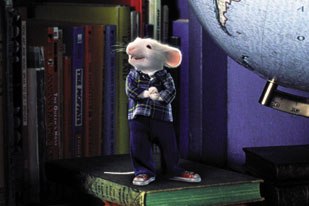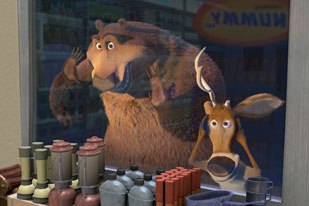In the second Open Season production diary, Sony Pictures Animation describes the establishment of a production pipeline in collaboration with Sony Pictures Imageworks for its first 3D-animated feature.

From the AWN/VFXWorld Exclusive Open Season Diaries.
It starts with a strong foundation.
For nearly a decade, navigating through the most explosive and dramatic shift in digital production, Sony Pictures Imageworks established one of the most robust production environments in the industry. During the period starting in 1997, Imageworks steadily grew its character animation capabilities, always with the goal of ultimately producing all-CG animated features. The roots of todays pipeline began production of Stuart Little.
The pipeline really involves four major areas: creative set-up, production management, technology, animation and rendering.
The basic production pipeline at Imageworks was strong and nimble enough to accommodate everything required for animation production. Much of the credit for this goes back to lessons learned on the Stuart Little films and the Academy Award-winning short The ChubbChubbs.
The ChubbChubbs was designed to break the system. The idea was to produce a short film with a wide array of characters, multiple detailed environments, expressive character animation and lots of visual effects. The project was also designed to test the technology and technical infrastructure at Imageworks to ensure that operation could support and manage the simultaneous production of an all-CG project at the same time as live-action visual effects. While The ChubbChubbs was in production, Imageworks was fully engaged on Harry Potter and the Sorcerers Stone, Stuart Little 2 and Spider-Man.
While the backend infrastructure at Imageworks had the technical firepower to support animation production, the first new addition to the production pipeline was the creative front end of animation.
Since Imageworks was well situated from the standpoint of producing the imagery, one of the first orders of business for Sony Pictures Animation was the establishment of full-fledged story and visual development departments. One of the reasons that Open Season has such a polished look is that there was already a strong base of animation talent in place when the unit was formed. The idea was to parlay the resident talent and additional artists whose talent and experience was even more animation specific. This was a largely talent driven component of the pipeline and the company was able to attract some of the very best artists in the business.

Look is so vital. Here we determined all of the locations, environments, color palette, props and all of the nuances that make this a complete production. It all comes down to set-up. The better the character models and rigs, the better the animators will be able to do their work. The same is true for the production design. Our job was to provide the artists with the best possible basis, a blueprint if you will, from which they could work their magic.
Interestingly, one element of the pipeline that weve been working on is asset management. Although Imageworks has always had to track digital props and objects, the volume of items and objects necessary for an all-CG feature was enormous. So the team significantly amped this capability and continues to refine it as we move into subsequent features.
Another addition to the pipeline was a set of tools to facilitate the essential scanning of storyboards and subsequent labeling and importation into the editorial department. This aspect was new to the Imageworks pipeline since it was specific to the requirements of animation.
Once we got into production, one of the biggest changes in the pipeline involved our Look-Ahead board. The key to successfully managing a show through the production pipeline is knowing exactly what work is ready to be done and needs to be done. By establishing our board, we were able to facilely move shots into the production queue as they advance through animation and optimize efficiency. We quickly realized a three-fold improvement in productivity.

One of the differences that we accommodated between visual effects and animation production was the nature of animation itself. In a visual effects environment, shots are boarded in preproduction, shot on a live-action set, edited into the movie and then turned over to the visual effects team with a pretty clear idea of what the final shot needs to look like. In animation, we are fond of saying that we dont have a full green light on a shot until it is finished. Sequences will often go back into story for refinement or new development and then return through layout before advancing fully into animation. This creates a more fluid environment that is a little different from the more rigid process typical in visual effects. The look ahead board helped us tremendously in keeping us on schedule. In fact, we completed the picture right on target.
Once animation was complete, the pipeline supported color and lighting, hair, fur, cloth, compositing and final rendering. Tremendous improvements were made in the software tools for hair and fur, resulting in the very richly detailed, layered look seen on Boog.
Most of the other tools, including Imageworks proprietary lighting tool, were consistent with the companys established pipeline.
The proof is in the final result. We believe the animation in Open Season is absolutely gorgeous .
Various artists at Sony Pictures Animation, who worked on Open Season, have contributed to the writing of this series of production diaries on the making of the film.







